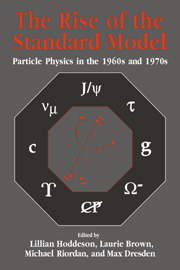Book contents
- Frontmatter
- Contents
- Contributors
- Editors' Acknowledgments
- Photographs of the Symposium
- Abbreviations and Acronyms
- Mathematical Notation
- Part One Introduction
- Part Two Quarks and Leptons
- Part Three Toward Gauge Theories
- Part Four Accelerators, Detectors, and Laboratories
- 15 The Rise of Colliding Beams
- 16 The CERN Intersecting Storage Rings: The Leap into the Hadron Collider Era
- 17 Development of Large Detectors for Colliding-Beam Experiments
- 18 Pure and Hybrid Detectors: Mark I and the Psi
- 19 Building Fermilab: A User's Paradise
- 20 Panel Session: Science Policy and the Social Structure of Big Laboratories
- 21 Some Sociological Consequences of High-Energy Physicists' Development of the Standard Model
- 22 Comments on Accelerators, Detectors, and Laboratories
- Part Five Electroweak Unification
- Part Six The Discovery of Quarks and Gluons
- Part Seven Personal Overviews
- Index
17 - Development of Large Detectors for Colliding-Beam Experiments
Published online by Cambridge University Press: 03 February 2010
- Frontmatter
- Contents
- Contributors
- Editors' Acknowledgments
- Photographs of the Symposium
- Abbreviations and Acronyms
- Mathematical Notation
- Part One Introduction
- Part Two Quarks and Leptons
- Part Three Toward Gauge Theories
- Part Four Accelerators, Detectors, and Laboratories
- 15 The Rise of Colliding Beams
- 16 The CERN Intersecting Storage Rings: The Leap into the Hadron Collider Era
- 17 Development of Large Detectors for Colliding-Beam Experiments
- 18 Pure and Hybrid Detectors: Mark I and the Psi
- 19 Building Fermilab: A User's Paradise
- 20 Panel Session: Science Policy and the Social Structure of Big Laboratories
- 21 Some Sociological Consequences of High-Energy Physicists' Development of the Standard Model
- 22 Comments on Accelerators, Detectors, and Laboratories
- Part Five Electroweak Unification
- Part Six The Discovery of Quarks and Gluons
- Part Seven Personal Overviews
- Index
Summary
There is a remarkable similarity among the modern collider detectors operating at many diverse facilities. For example, the experiments running for the past several years at LEP, the SLD detector just beginning to operate at the SLAC Linear Collider, the detectors now coming into operation at HERA, and those planned for the SSC and CERN's Large Hadron Collider all look quite similar to one another even though the colliders on which they function are quite different. I believe that there are simple and understandable reasons for this similarity.
The present situation contrasts markedly with that of the detectors employed in the first collider experiments during late 1960s and early 1970s – essentially the same period we are studying at this Symposium. In the early colliding-beam experiments, many different detector architectures were tried; out of all those ideas came a “standard model” of detectors, the cylindrically symmetric, solenoid-magnet detector that so dominates colliding-beam experiments today. For example, the first detectors at the early storage rings – CBX at Stanford, ACO at Orsay, the VEPP machines at Novosibirsk – were visual detectors, involving spark chambers and other techniques; they were designed to study specific final states over limited ranges of solid angle, with little or no particle identification, limited trigger capability, and no momentum analysis. They were not, as one would say today, general-purpose detectors.
- Type
- Chapter
- Information
- The Rise of the Standard ModelA History of Particle Physics from 1964 to 1979, pp. 299 - 307Publisher: Cambridge University PressPrint publication year: 1997
- 1
- Cited by

